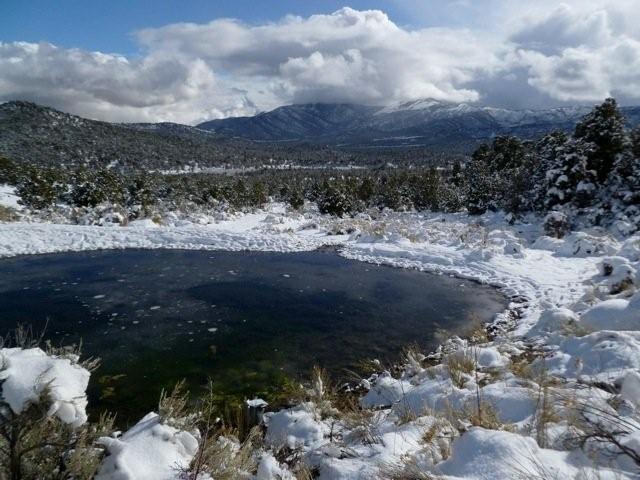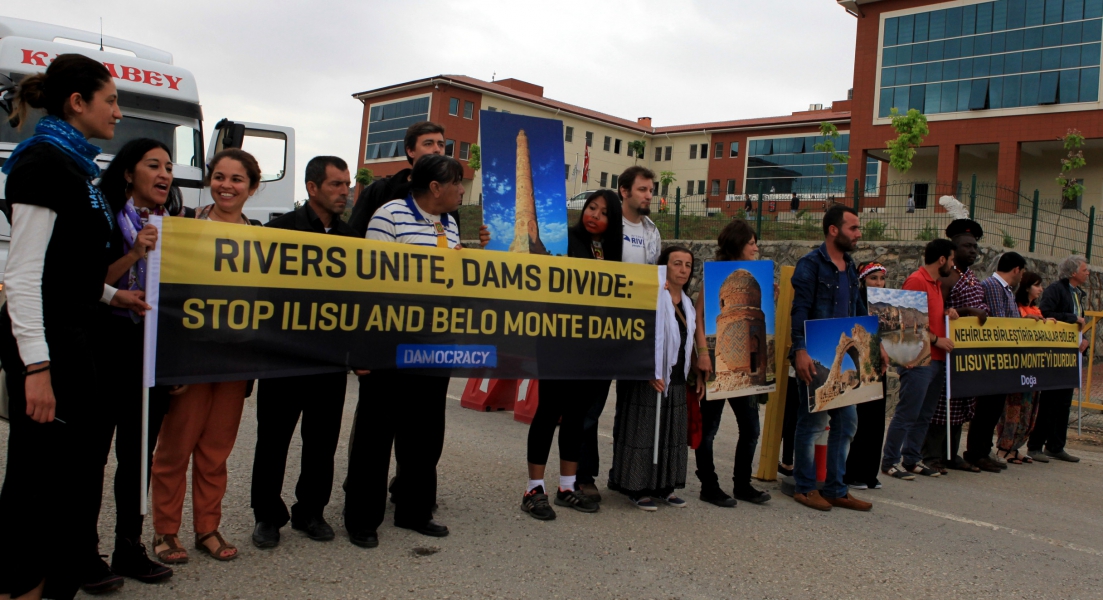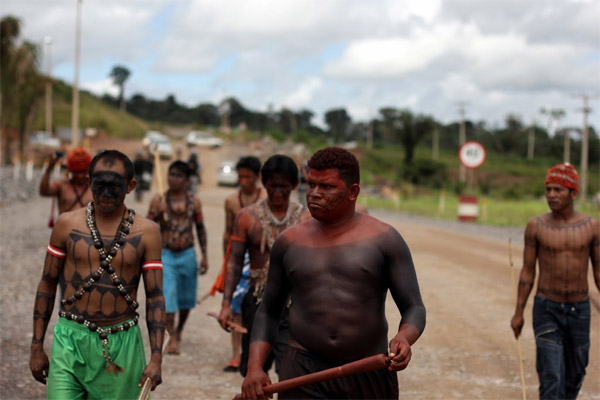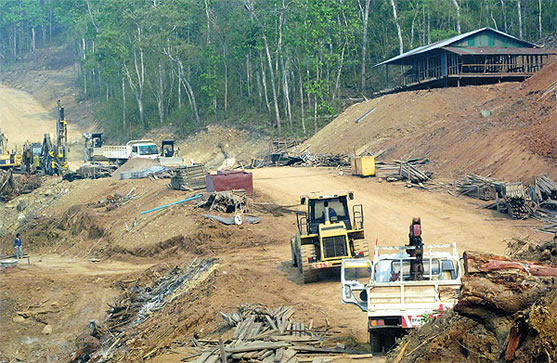
Groundwater Pipeline Threatens Great Basin Desert, Indigenous Groups
nBy Michael Carter, Deep Green Resistance Colorado Plateau
The Pipeline Proposal
The Great Basin stretches from Utah’s Great Salt Lake to the Sierra Nevada Mountains and from southern Idaho to southern California. About seven inches of rain falls in Nevada a year, and some areas receive less than five. The Great Basin is a cold desert, and in eastern Nevada and western Utah, it has been getting drier for a decade. [1]
The Southern Nevada Water Authority (SNWA), the water agency for Las Vegas, Henderson, and North Las Vegas, proposes pumping up to 200,000 acre-feet annually from eastern to southern Nevada through 300 miles of pipeline. An acre-foot is enough water to cover an acre of land a foot deep, or about 325,850 US gallons. Cost estimates vary from $3.5 billion (what SNWA tells the public) to $15 billion dollars (what SNWA was required by law to tell the State Engineer). This project is seen as a threat by several Indian tribes and rural communities, and is expected to do immense damage to many rare endemic species, desert vegetation, and the land itself, much of which is open range. [2]
Basin and Range
Life in the Great Basin’s valleys, human and otherwise, depends on shallow groundwater, springs, and creeks, which in turn depend on groundwater flows from rain and snow in mountain ranges. 200,000 acre-feet is about 65 billion gallons of water, equivalent to the average flow of Nevada’s Humboldt River. SNWA claims that it can pump this water from the Spring, Delamar, Dry Lake, and Cave Valleys without harm; though it’s clear to those who live in the Great Basin that if most of the water flowing in from the mountains is drawn away, eventually most everything in the valleys will die.
The Bureau of Land Management’s final decision on the right-of-way for the project [3] allows for the pumping of 150,000 annual acre-feet. [4] A drawdown projection commissioned by the Goshute Tribe [5] (and other analyses) reflect a far more destructive outcome than the SNWA claims. Access to Snake Valley (much of which is in Utah) groundwater is still in dispute, but the US Geological Survey has concluded the multiple valleys’ aquifers are connected, so it’s likely that Utah’s groundwater would be impacted anyway. [6]
According to the Great Basin Water Network, “Independent hydrologists dispute it is possible to pump and export so much water without causing major environmental degradation and destroying the livelihoods of rural residents in eastern Nevada and western Utah. The area targeted for the massive pumping proposal is home to National Wildlife Refuges… Great Basin National Park is surrounded by the proposed groundwater pump and export project. The proposed pumping scheme would bring two hundred or more wells with power lines, roads, and linked buried pipelines to cover the valleys on both sides of the National Park—some right on the border of the park.
Communities like Baker, Nevada on the Utah border would have large production wells in their backyard sending local water to a city 300 miles away.” [7] As pipeline foe Rick Spilsbury puts it, “This would mean the end of any economic development anywhere near the drained areas. The likely result would be a mass emigration and the eventual transformation of the area into a national toxic dump site.” Impacts to land, water, and air could extend as far as Salt Lake City and its surrounding urban areas (which already have some of the worst air pollution in the US). Physicians for Social Responsibility predicts a dewatered basin-and-range country could increase downwind particulate pollution from dust storms, including the toxic mineral erionite. [8] In textbook fashion, the city of Las Vegas is exporting suffering and violence to import resources that it cannot acquire in its immediate landbase.
Overdrawn River
Author Marc Reisner wrote, “To some conservationists the Colorado River is the preeminent symbol of everything mankind has done wrong—a harbinger of a squalid and deserved fate. To its preeminent impounder, the US Bureau of Reclamation, it is the perfection of an ideal.” [9] In 2013, American Rivers announced the Colorado as the US’s most endangered river, and that “over-allocation and drought have placed significant stress on water supplies, river health, and fish and wildlife. To underscore the immediacy of the problem, the basin is facing another drought this summer. The Bureau of Reclamation’s report released in December stresses that there is not enough water to meet current demands across the basin, let alone support future demand increases.” [10]
Under the interstate Colorado River Compact of 1922, the entire state of Nevada was allowed 300,000 acre feet per year (AFY) of Colorado River water. One AFY is approximately 3380 liters per day, “the planned water usage of a suburban family household, annually. In some areas of the desert Southwest, where water conservation is followed and often enforced, a typical family uses only about 0.25 [AFY].” [11] The Imperial Irrigation District, whose water rights predate the 1922 Compact, owns approximately three million acre feet (MAF) per year, and the entire city of Los Angeles uses about one MAF per year. Though laws controlling the use of water are typically state, not federal, and vary widely from state to state (in Arizona, for instance, there is little legally recognized relationship between ground and surface water), the 1922 Compact is a binding agreement between states. The Upper Basin must deliver a total of 7.5 MAF per year to the Lower Basin (the dividing line is at Lee’s Ferry in Glen Canyon, in Utah), and the US must deliver one MAF a year to Mexico. [12] Across the entire Colorado River basin, nearly all climate models predict an increase in both aridity and flooding. [13]
As increasing temperatures force the jet stream further north and more water evaporate from soil and reservoirs like Lake Powell (where an average 860,000 acre-feet of water—about 8 percent of the Colorado River’s annual flow—is lost every year) [14], overall water availability will decrease even if summer storms and spring runoff paradoxically become more intense. 2012 was the first recorded year the Colorado River flow peaked in April. [15] Though the water level in Lake Mead (where Las Vegas siphons its water from) has priority over Lake Powell’s (upstream), Las Vegas has little water from the river’s apportionment overall because in 1922, when the Compact was made, there were very few people in Nevada and no guess at what Las Vegas might become.
Southern Nevada at one point had the highest growth rate in the US, but following the economic recession Nevada had the highest national rate of foreclosures, bankruptcies, and unemployment. In 2010, there were 167,564 empty houses in Nevada—one in seven. In Las Vegas, residential property prices have fallen by 50 percent on average from 2008 to 2011, when Nevada homes changed hands for an average of $115,000. [16] As one SNWA pipeline opponent remarked, “My house in Las Vegas dropped from $307,500 to be foreclosed, and then resold at $190,000.”
When the SNWA groundwater pipeline was first conceived, the water agency was planning for growth on a much higher trajectory, and this momentum has carried through the recession to the present day. So while southern Nevada’s water future in general is threatened by drought and Nevada’s small original apportionment, the groundwater pipeline is driven by hopes for future growth, not immediate need. [16]
Indigenous Human Rights
The Confederated Tribes of the Goshute, or CTGR (the name “Goshute” derives from the native word Ku’tsip or Gu’tsip, people of ashes, desert, or dry earth), [17] “reside in an isolated oasis in the foothills of the majestic Deep Creek Mountains on what is now the Utah/ Nevada state line,” according to their web page Protect Goshute Water. There are 539 enrolled tribal members, and about 200 of them live in Deep Creek Valley. “Our reservation lies in one of the most sparsely populated regions of the United States, and it has always been our home. Resulting from this isolation, we have benefited by retaining strong cultural ties to Goshute land, our traditions, and a resolute determination to protect our ways.
Ironically, water, the most elemental resource in our basin, is the very thing developers now seek to extract and send 300 miles away for Las Vegas suburbs. The Southern Nevada Water Authority’s pipeline proposal would draw 150,000 acre feet per year from the Great Salt Lake Watershed Basin lowering the water table, drying up our springs, and fundamentally changing access to water over this vast region for plants, wildlife, and people.” They go on to say that “SNWA’s groundwater development application is the biggest threat to the Goshute way of life since European settlers first arrived on Goshute lands more than 150 years ago.” [18]
In Spring Valley in eastern Nevada, a narrow band of swamp cedar trees mark the site of 1863 and 1897 US military massacres of Goshute and Shoshone peoples, and here is where the Goshute and Duckwater and Ely Shoshone tribes grieve and hold spiritual ceremonies. Goshute tribal chairman Ed Naranjo says that “Swamp Cedars is important to many tribes, certainly to CTGR, Ely, and Duckwater, but also to many Paiute, Shoshone, and Ute Tribes.” The Swamp Cedars Massacre is relatively obscure, compared to well-known massacres at Bear River [19] and Wounded Knee.
Goshute elders believe that murder victims physically and spiritually fed the swamp-cedar trees; according to former Goshute council chairman Rupert Steele, “Otherwise you’d never see swamp cedar grow this tall and strong.” In a 2011 Nevada State Engineer hearing, an SNWA attorney likened the Goshute beliefs to children fearing the bogeyman. The Spring Valley swamp cedar grove is one of many sites that could be drained by the SNWA pipeline. [20] A “Cultural Property and Cultural Landscape” report on Spring Valley, Nevada, prepared by an independent ethnographer for Goshute and Ely and Duckwater Shoshone tribes was ignored by the BLM in their environmental analysis. [21]
Rick Spilsbury, a Shoshone Indian, says that “As far as the Native Americans of Nevada and Utah are concerned, this is just a continuation of the land and resource grab that has existed since the authoring of the Bill of Rights. Those who take have been writing the rules. The Colorado River Compact was organized specifically to exclude Native Americans and Mexicans from having any water rights. And the omission of Federal water protections for Native Americans from State water affairs was obviously not an oversight, or it would have been fixed by now. Native Americans don’t have the legal ability to stop their exploitation. [22]
“The Western Shoshone still hunt and gather here—right where the worst of the environmental damage will be. The mass killing of life in this area will not only be the final blow to Western Shoshone culture, it will be a serious threat to their long-term sustainability—and even viability. Water is life. And SNWA intends to take it.”
Opposition
Not surprisingly, a water appropriation on this scale has been hard fought by those whose livelihoods will be affected, as well as indigenous communities and environmental groups. Even within southern Nevada there’s some rate-payer opposition [23]—the project’s costs will be added to water bills—and Utah’s governor Gary Herbert recently rejected a proposed agreement with the SNWA for Snake Valley groundwater. [24] Litigation on various aspects of this project may well proceed to the US Supreme Court.
(Though Herbert’s decision was widely praised by both West Desert ranchers and environmentalists, not everyone in Utah concurred. Ron Thompson, of the Washington County, Utah, Water Conservancy District, criticized the move as “hypocritical for us to tell Nevada not to develop a water project. Ultimately they will figure out how to do it.” [25] Washington County wants to build its own expensive water pipeline from Lake Powell to the St. George area, and Thompson thinks Governor Herbert is sacrificing a “positive tradition of bi-state cooperation” in turning the SNWA down. A Lake Powell pipeline opponent observed that “It’s imperative that opposition to both projects stays active and coordinated.” [26])
Deep Green Resistance’s Southwest Coalition proposes this strategy:
Though we’re too recently involved to have any legal standing, our emphasis on indigenous solidarity has drawn us to ally ourselves with the affected indigenous groups. Though their governments haven’t agreed to any formal affiliation, we offer them support through:
1. Organizing opposition in communities outside the reservations.
2. Fundraising for efforts to fight the pipeline, whatever that might be. Donations are tax-deductible and can be made by PayPal to deepgreenfertileground@gmail.com. Please put “SNWA” in the comments section. The Great Basin Water Network also accepts donations, at or Great Basin Water Network, P O Box 75, Baker, NV 89311 (Nevada non-profit #35-2278153).
3. Influencing public opinion and promoting taxpayer opposition to the pipeline.
4. Sponsoring educational events and outreach. This might include inviting indigenous people (and supporting travel costs) to events we can organize in Salt Lake City and Las Vegas to speak against the pipeline.
5. Organizing protests and rallies. We can help redefine this issue as one of human rights violation, not only environmental destruction.
6. Encouraging negative press coverage of the SNWA and pipeline proposal. Encouraging positive press coverage of the Great Basin’s unique beauty, and the long indigenous people’s relationship with it.
7. Discouraging project investors/lenders.
8. We can also organize and train for nonviolent civil disobedience to fight the pipeline construction, should legal or administrative efforts fail. This is a tactical tool that’s aimed at physically stopping construction. It’s not symbolic, it’s strategic; there are ways of minimizing the expense and suffering to activists and maximizing expense and delay of the enemy, and we feel it’s best to plan for the unfortunate possibility that this struggle may well arrive at this point. We believe it’s our responsibility as privileged members of the dominant culture to put our bodies between the bulldozers and indigenous peoples and lands.
Miscellaneous Articles
- “Goshutes blast BLM study on Las Vegas water pipeline,” Las Vegas Review-Journal, August 5, 2012, http://www.lvrj.com/news/goshutes-blast-blm-study-on-las-vegas-water-pipeline-165082706.html
- Joe Schoenmann, “Water Authority gets state agency’s backing for pipeline to transport water from Lincoln, White Pine counties,” Las Vegas Sun, September 12, 2012, http://www.lasvegassun.com/news/2012/sep/12/water-authority-gets-state-agencys-backing-pipelin/
- Cy Ryan, “Environmental impact statement issued for proposed water pipeline,” Las Vegas Sun, August 3, 2012, http://www.lasvegassun.com/news/2012/aug/03/environmental-impact-statement-issued-proposed-wat/
- David McGrath Schwartz, “Nevada leaders largely silent on pipeline controversy,” Las Vegas Sun, October 14, 2011, http://www.lasvegassun.com/news/2011/oct/14/nevada-leaders-largely-silent-pipeline-controversy/
- Tara Lohan, “Las Vegas Accused of Engineering Massive Water Grab: Is This the Future of the West?” AlterNet, January 25, 2013, http://www.alternet.org/environment/las-vegas-accused-engineering-massive-water-grab-future-west-photo-slideshow?image-1=11&paging=off
Endnotes
[1] “Great Basin Water Issues,” Great Basin Water Network, accessed December 26, 2012, http://www.greatbasinwater.net/issues/index.php This page offers a good overview of Great Basin water issues, including the SNWA proposed pipeline.
See the U.S. Drought Monitor for current data: The U.S. Drought Monitor. National Drought Mitigation Center at the University of Nebraska-Lincoln, United States Department of Agriculture, National Oceanic and Atmospheric Administration. http://droughtmonitor.unl.edu/
[2] The U.S. Drought Monitor. National Drought Mitigation Center at the University of Nebraska-Lincoln, United States Department of Agriculture, National Oceanic and Atmospheric Administration. http://droughtmonitor.unl.edu/
[3] Sandra Chereb, “BLM approves Las Vegas water pipeline project,” Las Vegas Review-Journal, December 27, 2012, http://www.lvrj.com/news/blm–approves–las–vegas–water–pipeline–project-184948361.html
“Clark, Lincoln, and White Pine Counties Groundwater Development Project Final EIS,” US DEPARTMENT OF THE INTERIOR BUREAU OF LAND MANAGEMENT, August 3, 2012, http://www.blm.gov/nv/st/en/prog/planning/groundwater_projects/snwa_groundwater_project/final_eis.html
“Clark, Lincoln, and White Pine Counties Groundwater Development Project EIS Record of Decision,” U.S. DEPARTMENT OF THE INTERIOR BUREAU OF LAND MANAGEMENT, December 27, 2012, http://www.blm.gov/nv/st/en/prog/planning/groundwater_projects/snwa_groundwater_project/record_of_decision.html
[4] “SNWA appears as if it’s planning on Snake Valley water, said Rob Mrowka of the Tucson-based Center for Biological Diversity.
Despite the fact that the Nevada engineer approved water rights of 84,000 acre feet, he said, the BLM is set to approve a pipeline capable of carrying 117,000 acre feet.” Christopher Smart, “BLM poised to OK Las Vegas plan to pump and pipe desert groundwater,” Salt Lake Tribune, August 6, 2012, http://www.sltrib.com/sltrib/politics/54624691-90/blm–eis–final–las.html.csp
Brian Maffly, “BLM’s decision on Nevada-Utah pipeline called ‘pure folly’; Right of way helps southern Nevada, but Utah’s Snake Valley water not in play—yet,” Salt Lake Tribune, December 28, 2012, http://www.sltrib.com/sltrib/news/55538357-78/nevada–blm–decision–groundwater.html.csp
[5] “Ancestral Lands/Drawdown Scenario Map,” Protect Goshute Water, accessed May 10, 2013
[6] “While the BLM’s final EIS spares Snake Valley along the Utah-Nevada border from groundwater pumping, critics say drilling in nearby valleys will draw down the aquifer beneath Snake Valley,” “Goshutes blast BLM study on Las Vegas water pipeline,” Las Vegas Review-Journal, August 5, 2012, http://www.lvrj.com/news/goshutes–blast–blm–study–on–las–vegas–water–pipeline-165082706.html
[7] “Great Basin Water Issues,” Great Basin Water Network, accessed May 11, 2013, http://www.greatbasinwater.net/issues/index.php
[8]“Dr. Jeff Patterson, president of PSR [Physicians for Social Responsibility], said Westerners should be worried because there is no evidence of any serious attempt to determine if erionite exists in the same areas that would be ‘de-watered by the proposed Las Vegas pipeline and would be kicked up in the particulate pollution. Erionite can cause serious lung disease and a highly lethal cancer called mesothelioma,’” Brian Moench, “No end to Nevada’s quest for water,” Salt Lake Tribune, April 6, 2013, http://www.sltrib.com/sltrib/opinion/56107724-82/utah–nevada–erionite–las.html.csp
[9] Reisner, Marc. Cadillac Desert. New York: Viking Penguin, 1986, 121.
[10] Amy Souers Kober, “Announcing America’s Most Endangered Rivers of 2013,” American Rivers, April 17, 2013, https://web.archive.org/web/20130531040706/http://www.americanrivers.org/newsroom/blog/akober-20130417-announcing-americas-most-endangered-rivers-2013.html
[11] Acre-foot,” Wikipedia, accessed May 14, 2013, http://en.wikipedia.org/wiki/Acre–foot
[12] The Colorado River is managed and operated under numerous compacts, federal laws, court decisions and decrees, contracts, and regulatory guidelines collectively known as ‘The Law of the River,’” “Colorado River Compact,” Wikipedia, accessed May 14, 2013, http://en.wikipedia.org/wiki/Colorado_River_Compact
[13] Melanie Lenart, “Precipitation Changes,” Southwest Climate Change Network, September 18, 2008, http://www.southwestclimatechange.org/node/790#references
Gregory J. McCabe, David M. Wolock, “Warming may create substantial water supply shortages in the Colorado River basin,” Geophysical Research Letters, Volume 34, Issue 22, November 27, 2007, http://onlinelibrary.wiley.com/doi/10.1029/2007GL031764/abstract;jsessionid=400E4E84287315178759E2F3CEDCB107.d02t03
[14] “Glen Canyon Dam,” Wikipedia, accessed December 10, 2012, http://en.wikipedia.org/wiki/Glen_Canyon_Dam
[15] COLORADO BASIN RIVER FORECAST CENTER , NATIONAL WEATHER SERVICE / NATIONAL OCEANIC AND ATMOSPHERIC ADMINISTRATION, accessed May 11, 2013, http://www.cbrfc.noaa.gov/rmap/peak/peakpoint.php?id=CCUC2
[16] Nick Allen, “Las Vegas: how the recession has hit Sin City,” The Telegraph, May 16, 2011, http://www.telegraph.co.uk/news/worldnews/northamerica/usa/8517423/Las-Vegas-how-the-recession-has-hit-Sin-City.html
[17] The Confederated Tribe of the Goshute. Pia Toya: A Goshute Indian Legend. Salt Lake City: University of Utah Press, 2000.
[18] “The Confederated Tribes of the Goshute Reservation,” Protect Goshute Water, accessed May 15, 2013
[19] Kristen Moulton, “At Bear River Massacre site, the names of the dead ring out,” Salt Lake Tribune, January 30, 2013, http://www.sltrib.com/sltrib/news/55727028-78/bear–massacre–river–shoshone.html.csp
[20] Stephen Dark, “Last Stand: Goshutes battle to save their sacred water,” Salt Lake City Weekly, May 9, 2012, http://www.cityweekly.net/utah/article-35-15894-last–stand.html?current_page=all
[21] Sylvester L. Lahren, Jr. Ph.D., “A Shoshone/Goshute Traditional Cultural Property and Cultural Landscape, Spring Valley, Nevada. Confidential and Proprietary Report for the Goshute Tribal Council,” Confederated Tribes of the Goshute Reservation, August 9, 2010.
[22] Christopher Smart, “Snake Valley water could land in U.S. Supreme Court,” The Salt Lake Tribune, August 7, 2012, http://www.sltrib.com/sltrib/politics/54642624-90/snake–valley–nevada–rights.html.csp
“Nevada Groundwater Conservation: The Problem,” Center for Biological Diversity, accessed December 26, 2012, http://www.biologicaldiversity.org/programs/public_lands/deserts/nevada/groundwater.html
Rob Mrowka, “Groups join together to confront water rights issue,” Desert Report, Center for Biological Diversity/Great Basin Water Network, June, 2011, accessed December 26, 2012, http://www.biologicaldiversity.org/programs/public_lands/deserts/nevada/pdfs/DR_Summer2011_Mrowka.pdf
George Knapp and Matt Adams, “I-Team: Court Ruling Emboldens Water Grab Opponents,” October 31, 2011,
[23] “Water pipeline hits opposition even in thirsty Vegas,” Salt Lake Tribune, August 16, 2011, http://www.sltrib.com/sltrib/news/52398491-78/vegas–las–nevada–utah.html.csp
[24] Christopher Smart, Judy Fahys and Brian Maffly, “Herbert rejects Snake Valley water pact with Nevada,” Salt Lake Tribune, April 3, 2013, http://www.sltrib.com/sltrib/news/56090274-78/valley–agreement–snake–utah.html.csp
[25] Brian Maffly, “Rejecting Nevada water deal hurts Utah, critics say,” Salt Lake Tribune, May 25, 2013,
[26] “Lake Powell Pipeline,” Citizens for Dixie’s Future, accessed May 27, 2013, http://citizensfordixie.org/lake–powell–pipeline/



